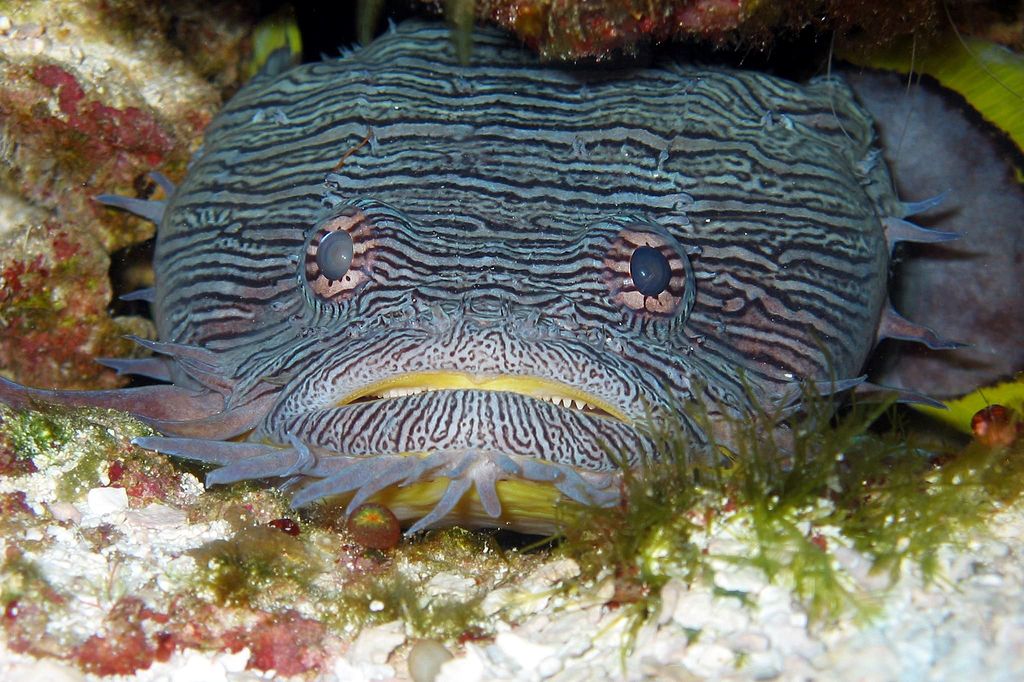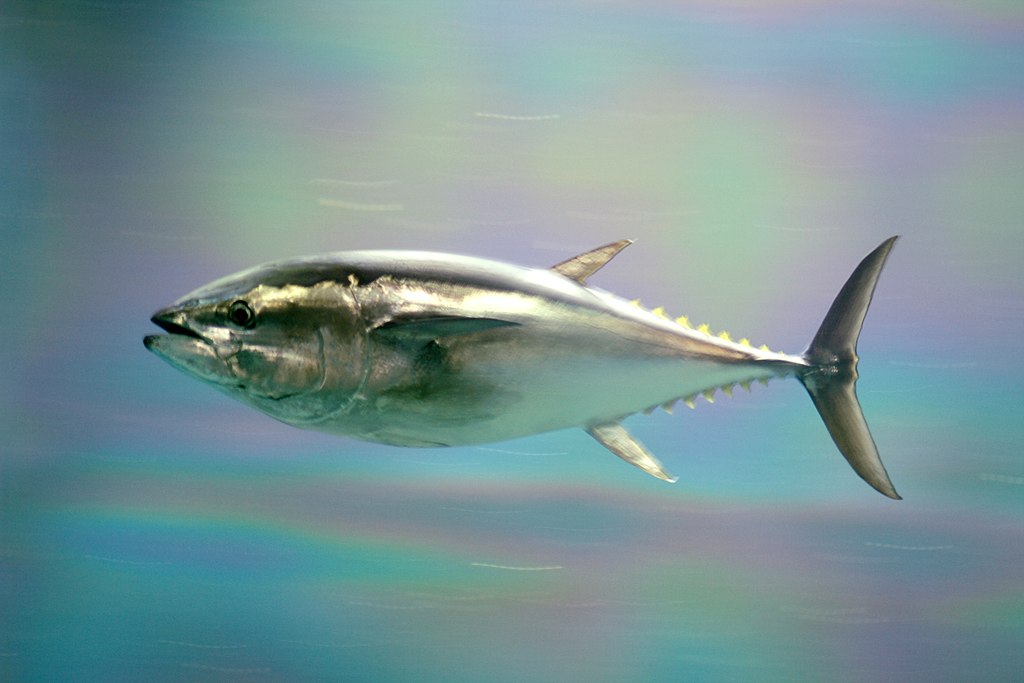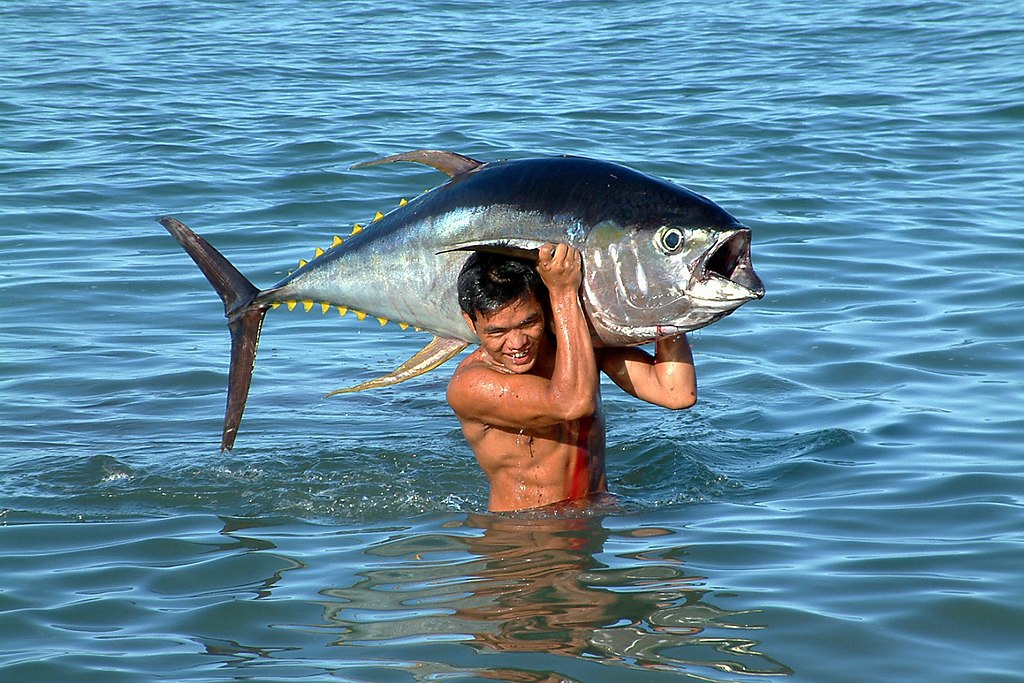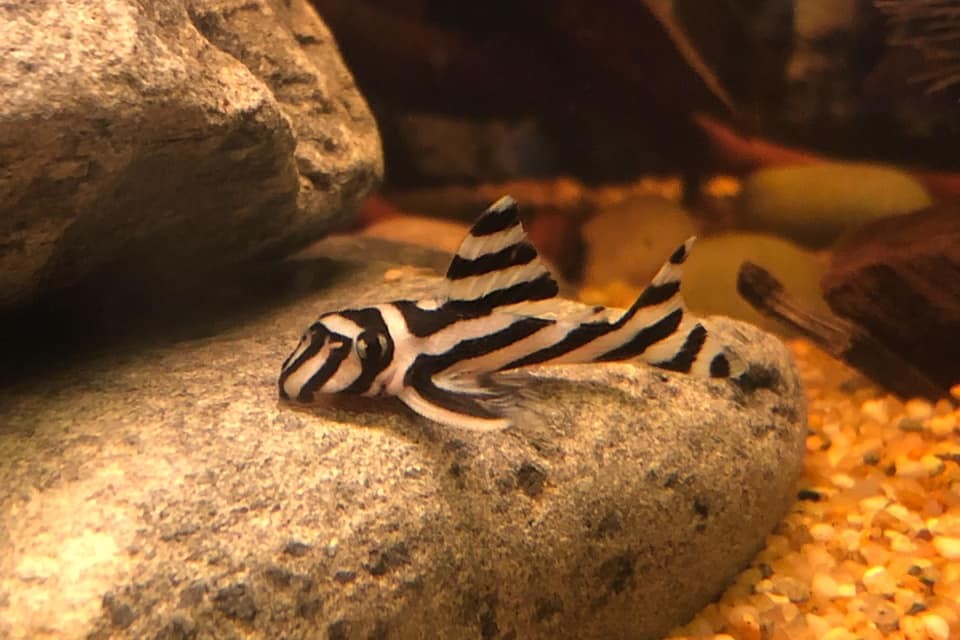
Eine Übersicht über die Keywords zum Verkehr. Hier können Sie leicht nach Schlüsselwörtern und Definitionen suchen, die Sie noch nicht kennen.
More subjects
Toadfish is the common name for a variety of species from several different families of fish, usually because of their toad-like appearance. 'Dogfish' is a name for certain species along the gulf coast.[clarification needed] Toadfish make up a notable portion of the dolphin's diet, approximately 13%. Scientific experiments have shown that the mating call of the toadfish alerts dolphin predators to the fish's location. Similarly, the sounds caused by the dolphin when hunting its prey alert toadfish to the location of the predators and cause the fish to silence their mating call. Male toadfish will reduce their mating calls by up to 50% when they hear the low sound of a dolphin's 'pop'. (Source: Wikipedia.org, CC BY-SA)
 © Wikimedia.org/Randall McNeely, CC0
© Wikimedia.org/Randall McNeely, CC0
Trout are species of freshwater fish belonging to the genera Oncorhynchus, Salmo and Salvelinus, all of the subfamily Salmoninae of the family Salmonidae. The word trout is also used as part of the name of some non-salmonid fish such as Cynoscion nebulosus, the spotted seatrout or speckled trout. Trout are closely related to salmon and char (or charr): species termed salmon and char occur in the same genera as do fish called trout (Oncorhynchus – Pacific salmon and trout, Salmo – Atlantic salmon and various trout, Salvelinus – char and trout). (Source: Wikipedia.org, CC BY-SA)
A tuna is a saltwater fish that belongs to the tribe Thunnini, a subgrouping of the Scombridae (mackerel) family. The Thunnini comprise 15 species across five genera, the sizes of which vary greatly, ranging from the bullet tuna (max length: 50 cm or 1.6 ft, weight: 1.8 kg or 4 lb) up to the Atlantic bluefin tuna (max length: 4.6 m or 15 ft, weight: 684 kg or 1,508 lb), which averages 2 m (6.6 ft) and is believed to live up to 50 years. Tuna, opah and mackerel sharks are the only species of fish that can maintain a body temperature higher than that of the surrounding water. An active and agile predator, the tuna has a sleek, streamlined body, and is among the fastest-swimming pelagic fish – the yellowfin tuna, for example, is capable of speeds of up to 75 km/h (47 mph). Greatly inflated speeds can be found in early scientific reports and are still widely reported in the popular literature. (Source: Wikipedia.org, CC BY-SA)
 © Wikimedia.org/aes256, CC BY-JP
© Wikimedia.org/aes256, CC BY-JP
Wahoo (Acanthocybium solandri) is a scombrid fish found worldwide in tropical and subtropical seas. It is best known to sports fishermen, as its speed and high-quality flesh makes it a prized and valued game fish. In Hawaii, the wahoo is known as ono. The species is sometimes called hoo in the United States. Its body is elongated and the back is an iridescent blue, while the sides are silvery with a pattern of irregular vertical blue bars. These colors fade rapidly during death. The mouth is large, and the teeth of the wahoo are razor sharp. Both the upper and lower jaws have a somewhat sharper appearance than those of king or Spanish mackerel. Specimens have been recorded at up to 2.5 m (8 ft 2 in) in length, and weighing up to 83 kg (183 lb). Growth can be rapid. They are among the fastest fish in the sea. (Source: Wikipedia.org, CC BY-SA)
The walking catfish (Clarias batrachus) is a species of freshwater airbreathing catfish native to Southeast Asia. It is named for its ability to 'walk' and wiggle across dry land, to find food or suitable environments. While it does not truly walk as most bipeds or quadrupeds do, it has the ability to use its pectoral fins to keep it upright as it makes a wiggling motion with snakelike movements to traverse land. This fish normally lives in slow-moving and often stagnant waters in ponds, swamps, streams, and rivers, as well as in flooded rice paddies, or temporary pools that may dry up. When this happens, its 'walking' skill allows the fish to move to other aquatic environments. Considerable taxonomic confusion surrounds this species and it has frequently been confused with other close relatives. One main distinction between the walking catfish and the native North American ictalurid catfish with which it sometimes is confused, is that the walking catfish lacks an adipose fin. (Source: Wikipedia.org, CC BY-SA)
The walleye (Sander vitreus, synonym Stizostedion vitreum), also called the yellow pike or yellow pickerel, is a freshwater perciform fish native to most of Canada and to the Northern United States. It is a North American close relative of the European zander, also known as the pikeperch. The walleye is sometimes called the yellow walleye to distinguish it from the blue walleye, which is a color morph that was once found in the southern Ontario and Quebec regions, but is now presumed extinct. However, recent genetic analysis of a preserved (frozen) 'blue walleye' sample suggests that the blue and yellow walleye were simply phenotypes within the same species and do not merit separate taxonomic classification. In parts of its range in English-speaking Canada, the walleye is known as a pickerel, though the fish is not related to the true pickerels, which are members of the family Esocidae. (Source: Wikipedia.org, CC BY-SA)
 © Wikimedia.org/Engbretson Eric, CC0
© Wikimedia.org/Engbretson Eric, CC0
The wels catfish (/ˈwɛls/ or /ˈvɛls/; Silurus glanis), also called sheatfish or just wels, is a large species of catfish native to wide areas of central, southern, and eastern Europe, in the basins of the Baltic, Black and Caspian Seas. It has been introduced to Western Europe as a prized sport fish and is now found from the United Kingdom east to Kazakhstan and China and south to Greece and Turkey. It is a freshwater fish recognizable by its broad, flat head and wide mouth. Wels catfish can live for at least fifty years. (Source: Wikipedia.org, CC BY-SA)
The whale shark (Rhincodon typus) is a slow-moving, filter-feeding carpet shark and the largest known extant fish species. The largest confirmed individual had a length of 18.8 m (61.7 ft). The whale shark holds many records for size in the animal kingdom, most notably being by far the largest living nonmammalian vertebrate. It is the sole member of the genus Rhincodon and the only extant member of the family Rhincodontidae, which belongs to the subclass Elasmobranchii in the class Chondrichthyes. Before 1984 it was classified as Rhiniodon into Rhinodontidae. The whale shark is found in open waters of the tropical oceans and is rarely found in water below 21 °C (70 °F). Studies looking at vertebral growth bands and the growth rates of free-swimming sharks have estimated whale shark lifespans at 80–130 years. Whale sharks have very large mouths and are filter feeders, which is a feeding mode that occurs in only two other sharks, the megamouth shark and the basking shark. They feed almost exclusively on plankton and small fishes, and pose no threat to humans. (Source: Wikipedia.org, CC BY-SA)
Merlangius merlangus, commonly known as Whiting or merling, is an important food fish in the eastern North Atlantic Ocean and the northern Mediterranean, western Baltic, and Black Sea. In Anglophonic countries outside the Whiting's natural range, the name 'whiting' has been applied to various other species of fish. (Source: Wikipedia.org, CC BY-SA)
The wolf eel (Anarrhichthys ocellatus) is a species of marine ray-finned fish belonging to the family Anarhichadidae, the wolf fishes. It is found in the North Pacific Ocean. Despite its common name and resemblance, it is not a true eel. It is the only species in the monotypic genus Anarrhichthys. A. ocellatus differs from true eels, as they have paired gill slits and pectoral fins. The animal can grow up to 2.4 m (7 ft 10 in) in length and 18.4 kg (41 lb) in weight. Younger wolf eels are orange with big dark spots in the posterior part of the body. Once older they turn grey, brown greyish or dark olive. (Source: Wikipedia.org, CC BY-SA)
Anarhichadidae, the wolffishes, sea wolves or wolf eels, is a family of marine ray finned fishes belonging to the order Scorpaeniformes. These are predatory, eel shaped fishes which are native to the cold waters of the Arctic, North Pacific and North Atlantic Oceans. Anarhichadidae wolfishes have a largely compressed and, in the genus Anarhichas, a moderately elongate body. Anarrhichthys has an extremely elongate body and this has given rise to its common name of wolf-eel. The long dorsal fin starts at the head and has many flexible spines and soft rays. The anal fin may have a single spine in Anarrhichthys, and again there is a large number of soft rays. The caudal fin is separate from the other median fins in Anarhichas but they are all three joined in Anarrhichthys. There is a single pair of nostrils. (Source: Wikipedia.org, CC BY-SA)
The wrasses are a family, Labridae, of marine fish, many of which are brightly colored. The family is large and diverse, with over 600 species in 81 genera, which are divided into 9 subgroups or tribes. They are typically small, most of them less than 20 cm (7.9 in) long, although the largest, the humphead wrasse, can measure up to 2.5 m (8.2 ft). They are efficient carnivores, feeding on a wide range of small invertebrates. Many smaller wrasses follow the feeding trails of larger fish, picking up invertebrates disturbed by their passing. Juveniles of some representatives of the genera Bodianus, Epibulus, Cirrhilabrus, Oxycheilinus, and Paracheilinus hide among the tentacles of the free-living mushroom corals & Heliofungia actiniformis. (Source: Wikipedia.org, CC BY-SA)
Chaetodon daedalma or the wrought-iron butterflyfish is a species of marine ray-finned fish, a butterflyfish belonging to the family Chaetodontidae. It is native to the western Pacific ocean near central and southern Japan. Chaetodon daedalma is mainly metallic black in colour with yellow margins to the dorsal, anal and caudal fin. The body has some markings resembling a cross hatch in pattern. The scales, have pale yellow centres and broad black margins forming a lattice or netted pattern. The largely black colouration is very unusual for a species of butterflyfish which are normally much more colourful. This species attains a maximum total length of 15 centimetres (5.9 in). (Source: Wikipedia.org, CC BY-SA)
The yellowfin tuna (Thunnus albacares) is a species of tuna found in pelagic waters of tropical and subtropical oceans worldwide. Yellowfin is often marketed as ahi, from the Hawaiian ʻahi, a name also used there for the closely related bigeye tuna. The species name, albacares ('white meat') can also lead to confusion: in English, the albacore (Thunnus alalunga) is a different species, while yellowfin is officially designated albacore in French and referred to as albacora by Portuguese fishermen. (Source: Wikipedia.org, CC BY-SA)
 © Wikimedia.org/Shemlongakit, CC BY-SA
© Wikimedia.org/Shemlongakit, CC BY-SA
The zebra pleco (Hypancistrus zebra) is a species of catfish endemic to a small section of the Rio Xingu in Brazil. It occurs in the big bend area of the river, downstream from the town of Altamira, Para. It was first described in 1991. It gets its name from its black and white stripes, resembling the colouration of a zebra. This species grows to a length of 6.4 centimetres (2.5 in) SL. This species was exported from Brazil in for sale as aquarium fish. However, currently, the Brazilian government bans the export of certain fish species, including H. zebra. (Source: Wikipedia.org, CC BY-SA)
 © Wikimedia.org/Peaceinpianos, CC BY-SA
© Wikimedia.org/Peaceinpianos, CC BY-SA
The zebra shark (Stegostoma tigrinum) is a species of carpet shark and the sole member of the family Stegostomatidae. It is found throughout the tropical Indo-Pacific, frequenting coral reefs and sandy flats to a depth of 62 m (203 ft). Adult zebra sharks are distinctive in appearance, with five longitudinal ridges on a cylindrical body, a low caudal fin comprising nearly half the total length, and usually a pattern of dark spots on a pale background. Young zebra sharks under 50–90 cm (20–35 in) long have a completely different pattern, consisting of light vertical stripes on a brown background, and lack the ridges. This species attains a length of 2.5 m (8.2 ft). (Source: Wikipedia.org, CC BY-SA)

Time for recess! Post a comment, ask a question or write a review. Feel free to let us know what you think!
was bedeutet rechts oder links übergabe.für mich ist es eine Strassenteilung re oder li
In Malaysia gibt es gelbe und weiße Linien zum Begrenzen der Fahrbahnen. Was bedeutet eine weiße Linie und eine gelbe Linie im Zusammenhang mit dem Halten/Parken eines Autos. innerhalb einer Ortschaft?
Fehler: "Rechtsübergabe". Okay, dieser Test ist komplett unbrauchbar. Reine Zeitschwendung.
Fehler: Bei einem Richtungswegweiser ist die erwartete Antwort: "Informationen zum Ziel der Rampe.".
Fehler: Ein dreieckiges Schild mit einem Fahrrad ist eine Warnung *vor* Radfahrern. Keine Warnung *für* Radfahrern.
An sich ganz hilfreich, aber bei einem so sensiblen Thema die Texte dermaßen schlecht zu übersetzen, geht gar nicht! Die Antwortmöglichkeiten sind so verwirrend geschrieben, daß ich teilweise nicht wußte, was gemeint war, und dementsprechend Fehler kassiert habe. Ich biete mich hiermit an, die Übersetzungen zu überarbeiten.
Dear future partners! We are European manufacturers and distributors of buoys designed to serve road and highway maintenance, driver training and sports purposes. We kindly recommend our spaces to your attention at www. lorinciboja.hu website. if you have any questions, don't hesitate to contact us at info@lorincibolya.hu or at 36 20412 8898! Have a successful trip and days! Best regards! Imre Buczkó Manager
Es ist toll, dass es diesen Test / Seite gibt. Es sind doch viele Zeichen dabei die es so in Deutschland nicht gibt. MFG Franz
Liebe Parker und ParkerINNEN, die elektronische Parkscheibe oder Parkuhr ist so viel ich weiss, seit 2005 zugelassenen und doch zahlen wir lieber die Knöllchen zwischen 25 und über 40 EURO und ärgert sich ein Weilchen darüber. Ich bin nach der letzten Zahlung von 42 Euro endlich dem Rat unseres Dorfpolizisten gefolgt und habe mir eine elektronische Parkscheibe ins Auto geklebt. Die Uhr zeigt die Ankunftszeit beim Halt an der Parkstelle nach 20 Sekunden an. Ankunft 9:55=10:00 Uhr Ankunft 10:12=10:30 Uhr vor Ankunft 10:26=10:30 Uhr Ankunft 10:34=11:00 Uhr genau so soll man ja ďa gewohnte Parkscheibe auch einstellen Übrigens, die Kennzeichen am Auto sind heutzutage nicht mehr gegen Diebstahl gesichert, es ist ratsam die Teile mit Schrauben oder Nieten zu befestigen. Ich spreche aus leidvoller Erfahrung. MfG Günter Arlt
Bitte schreiben sie die Antworten in einem richtigen Deutsch. Sie sind so sehr verwirrend und man kann sie nicht verstehen.
Gostaria de saber se alguém tem as regras de trânsito em português. Não somente as placas de trânsito mas também as situações reais.
Auf Teneriffa ist es so, wenn die Markierungen schräg aufgezeichnet sind, dann muss Rückwärts eingeparkt werden. Sonst wird es mit bis zu 90,00€ geahndet.
Bitte überprüfen Sie Ihre Übersetzungungen. Kreuzhirsch? Links übergeben? Warnung FÜR Kinder? Kurve der Hauptstraße? Einreise verboten? Überfahrt von Fußgängern? Fahrern Platz machen? Gib nach? Obligatorisches Recht? Es ist so viel falsch übersetzt ...